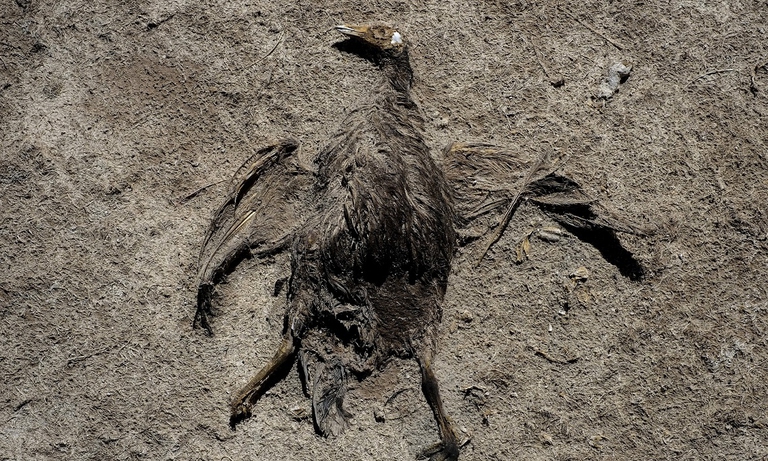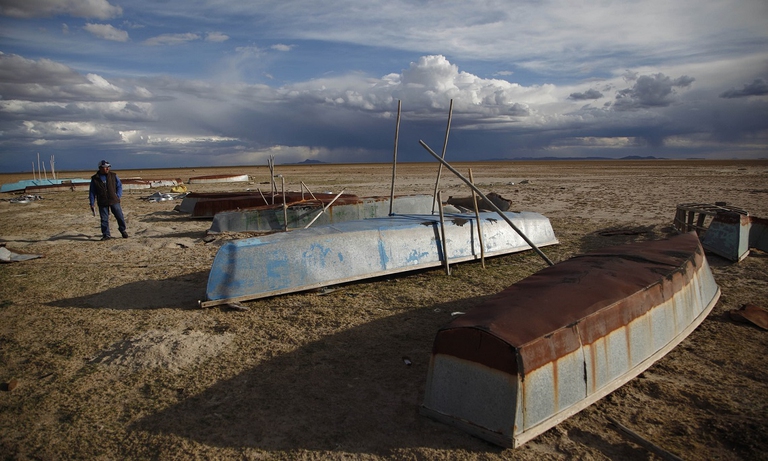
After a landslide led to twelve deaths on the island of Ischia, questions have been raised about the impacts of illegal building, tourism, and climate change.
Lake Poopó, Bolivia’s second largest lake behind Lake Titicaca located at an altitude of 3,686 metres, was once home to endemic fish, bird and plant species, and provided people with their livelihoods. Today, it is completely dry. Fish and birds carcasses are the silent demonstration of the ancient beauty of the area, now
Lake Poopó, Bolivia’s second largest lake behind Lake Titicaca located at an altitude of 3,686 metres, was once home to endemic fish, bird and plant species, and provided people with their livelihoods. Today, it is completely dry.
Fish and birds carcasses are the silent demonstration of the ancient beauty of the area, now turned into an arid desert. Lake Poopó was officially declared evaporated in December by Victor Hugo Vásquez, Governor of the Oruro Department, the Andean plateau between Bolivia and Peru that was home to the basin. Actually, it’s not the first time that the lake dries up: its extension has always been variable, being subordinated to levels of Desaguadero River.
However, according to scientists, the lake is not going to recover this time. “This is a picture of the future of climate change,” sadly said Dirk Hoffman, German glaciologist who studies the relationship between rising temperature due to fossil fuels and melting ice in Bolivia.
However, the evident average global temperature rise doesn’t seem to be the only cause of Lake Poopó demise. Indeed, experts also suggest the chronic drought derived from El Niño meteorological phenomenon, as well as the excessive man-related impacts.
The lake was in fact subject to an intensive exploitation: its tributaries’ waters were used for the irrigation of neighbouring countries’ lands, whilst Poopó was irreparably polluted by mining companies operating in the regions of Oruro and Potosì. Poopó waters have been thus contaminated by highly polluting substances, such as arsenic, lead, cadmium and zinc.
The over 100 families that lived in the village of Untavi, on the lake’s shores, were forced to sell sheep, llamas and alpacas and leave the area, now populated by elderly people only. “There’s no future here,” said 29-year-old Giovenale Gutierrez who moved to a nearby town, to The Guardian.
Angel Flores, head of a local citizens’ group that tried to save Poopó, said that government ignored warnings. “Something could have been done to prevent the disaster. Mining companies have been diverting and polluting water since 1982”.
In hopes of saving the lake, Boliva’s government asked the European Union 140 million dollars to use on plants for the treatment of waste water and for dredging tributaries.
Siamo anche su WhatsApp. Segui il canale ufficiale LifeGate per restare aggiornata, aggiornato sulle ultime notizie e sulle nostre attività.
![]()
Quest'opera è distribuita con Licenza Creative Commons Attribuzione - Non commerciale - Non opere derivate 4.0 Internazionale.
After a landslide led to twelve deaths on the island of Ischia, questions have been raised about the impacts of illegal building, tourism, and climate change.
Not much snow, peaks of 19 degrees Celsius in Norway and even 28 degrees in France: official data confirms the anomalously high temperatures of this past winter.
Ocean warming has risen to record highs over the last five years: just in 2019 the heat released into the world’s oceans was equivalent to that of 5-6 atomic bombs per second. The culprit, no doubt, is climate change.
What did Greta Thunberg tell participants at the 2020 World Economic Forum in Davos? Once again, the Swedish activist underlined the total lack of concrete solutions to the climate crisis presented by leaders so far.
The list of human and animal victims of the Australia wildfires keeps growing – one species might already have gone extinct – as the smoke even reaches South America.
Kivalina is located on a small island once guarded by sea ice, which is now melting due to global warming. While the sea threatens to wipe the village off the face of the Earth, its inhabitants refuse to give up their lives and traditions.
Thanks to activists, the voice of the world’s peoples resounded through the COP25 like an alarm bell. Governments didn’t reach the results they demanded, but their cries and messages were stronger than ever, reaching even those who weren’t in Madrid.
Climate change poses a risk for millions. However, women are the most vulnerable to its negative consequences: a few simple considerations by the Italian Climate Network help us perceive the global implications of this.
The COP25 ended two days late and with very few steps ahead made. Climate negotiations in 2020 will be an uphill battle as political will clearly seems to be lacking, once again.









